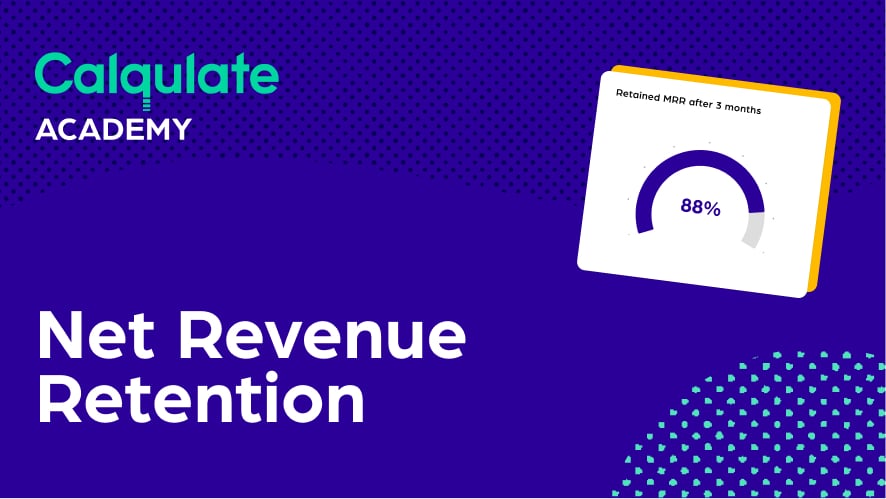You may wonder: If I have a customer retention rate of 95%, doesn’t that mean I have a high net revenue rate as well?
Not necessarily. Here’s why — customer retention rate is not the same as the NRR rate. Let's look at the actual meanings of customer retention and net revenue retention metrics:
Customer retention rate tells you the number of existing customers.
Net Retention rate (NRR) is a growth indicator that measures the performance of your business.
For example, if you retain 150 customers in a year, but they downgraded to lower plans and spent less than the previous year, your customer retention metric stays the same. However, your NRR rate will be lower.
You can use historical NRR in financial forecasting to improve your forecasting accuracy. You can also use it to make different departments accountable for their results by having an NRR and revenue targets. NRR target is a great element in performance-based compensation calculations.
So…what is Net Revenue Retention rate?
Net Revenue Retention (NRR) is the retained revenue from your existing customers. It’s a broad metric that gives you an idea of what your revenue streams will look like over time if there are no new customers.
The NRR formula takes into account:
- Expansion revenue (upgrades, cross-sells, or upsells)
- Downgraded revenue
- Churned revenue
These factors affect your Monthly Recurring Revenue (MRR). Having a high revenue retention rate indicates that you are expanding your business with your existing customers. After all, we know that a happy customer is more likely to spend more than a new customer.
How do I calculate my NRR rate?
The formula for calculating the NRR rate is simple:
[(MRR of the last month + Expansion revenue - Downgrades - Churn) / MRR of the last month] x 100% = NRR
Let’s walk through this example. Assuming you have 150 customers with an MRR of $100,000. Your expansion revenue through upgrades and cross-sell is $20,000. There were some downgrades and churn of $15,000 and $8,000 respectively. We now know:
MRR = $100,000
Expansion = $20,000
Downgrades = $15,000
Churn = $8,000
Therefore, your NRR rate is:
[($100,000 + $20,000 - $15,000 - 8,000) / $100,000] x 100% = 97%
Based on this, we know that your company is still growing, despite the losses incurred through churn and downgrades, even without acquiring any new customers. It means that your product offers a strong value proposition for your customers.
What if we change things a little? In this scenario, we will keep all the variables the same but use a lower expansion revenue of $8,000 and downgrades of $25,000. This is how your NRR rate will look like:
MRR = $100,000
Expansion = $8,000
Downgrades = $25,000
Churn = $8,000
[($100,000 + $8,000 - $25,000 - 8,000) / $100,000] x 100% = 75%
Based on this, we know that while there is a product fit for customers, something still needs to be done in order to expand your revenue with existing customers. It could mean your product requires you to develop additional features, improve your existing features, or revise your SaaS pricing.
An important thing to remember: you may see gaps in the data if your NRR reporting period is too short--for example, on a monthly basis. Calculating your NRR on a quarterly and annually basis will give you a better and more stable overview.
In a SaaS business, having an NRR rate of over 100 percent means that your business has a huge potential for growth. It means that your customers are willing to pay more for your product. The definition of what makes up a good NRR rate depends on your business. Typically, 90% is a good NRR rate for small and medium SaaS businesses, while at least 125% is what larger SaaS businesses aim for.
If you are currently selling your software for $100 per month, your goal is to expand this number from $100 to $200 per month with the existing customers. A good strategy to get a high NRR rate is to make the initial threshold as low as possible for your customers. And this is where your pricing strategy plays an important role.
For example, your potential customer may have a need for your product but is not ready to take the leap in paying a monthly subscription that is too high. You could begin with a starter subscription package that allows your customers access to your product. From there, you would have already obtained an MRR.
Now, your goal is to expand this number with this customer. Therefore, your pricing package should be built based on an upselling pathway in which these customers can easily upgrade through add-ons that suit their needs. And, voila! You have just expanded your revenue.
Key takeaway:
Your NRR rate is an important indicator of your company’s profitability because acquiring a new customer is much more costly than retaining an existing one. Therefore, by keeping and expanding your existing customer, you will eventually reduce your Customer Acquisition Cost (CAC) and increase your customer lifetime value instead. In addition, alongside your growth rate, your NRR rate also plays a crucial role in the valuation of your business.
Happy Calqulating!

